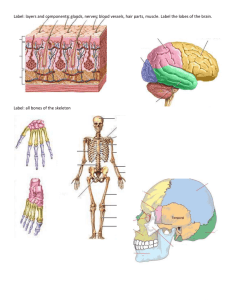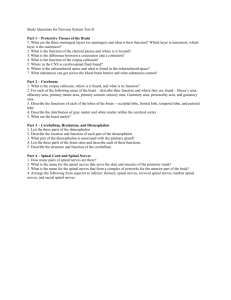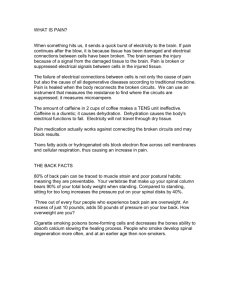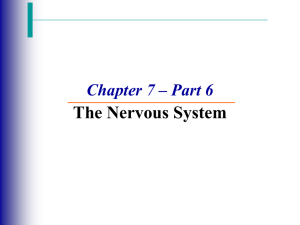Peripheral Neuropathy
advertisement
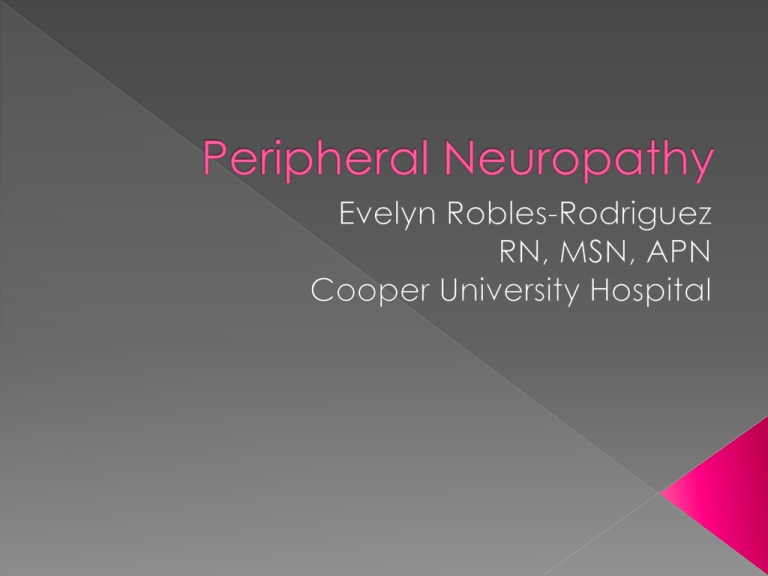
Irritation or damage to nerves outside the brain and spinal cord Causes difficulty in communication between nerves or group of nerves Long, wire-like fibers Transmit nerve impulses and sensory information from the body to the spinal cord Carry motor signals for muscle movement and other functions from the brain and spinal cord to rest of body and organs Chronic diabetes and uremia Infection which affects nerves such as shingles (post herpetic neuralgia) Excess alcohol Tumor pressing on a nerve Spinal cord injury Low vitamin B levels (especially B12) Poor circulation Damage to nerves can occur with: › Surgery › Radiation therapy › Chemotherapy Can cause damage to nerves near the surgical site Side effects reported with damage: › Burning › Shooting pain › Electric tingling › Numbness in skin around surgical site More common in 1960s with older treatments Much less common today but still can occur Side effects can include: › Weakness › Pain Polyneuropathy most common form of neuropathy (affects several nerves) Usually affects both sides of the body equally Symptoms usually begin in feet and can progress to hands (referred as “stocking/glove distribution”) Platinums (cisplatin, carboplatin, oxaliplatin) Taxanes (Taxol or paclitaxel, Taxotere or docetaxel) Epothilones (Ixabepilone or Ixempra) Plan alkaloids (vinblastine, vincristine, vinorelbine, etoposide) Thalidomide and lenalidomide (Revlimid) Bortezomib (Velcade) Pain (can be constant or come and go, shooting, electric or stabbing) Burning Tingling (“pins and needles”) Numbness (decreased sensation of pressure, touch, temperature) Increased sensitivity to temperature (especially cold), touch or pressure Difficulty using fingers to pick up, hold or handle things such as buttons, writing Problems with balance Tripping or stumbling with walking Shrinking or weak muscles Loss of or reduced reflexes Difficulty swallowing Urinary incontinence Constipation Impotence Dizziness with standing 3-7% in those treated with single agents 38% in those treated with multiple agents Can begin anytime after treatment starts Sometimes occurs at end of treatment Can worsen as treatments go on Can be short term › Last a few days › Stop after treatment ends Can be long term › Persist between treatments › Continue 6-24 months after treatment ends Can become a permanent problem Age Genetic predisposition Chronic conditions (diabetes, kidney failure, HIV) Amount of each dose of chemo Total dose of chemo Drug combination Previous chemo Previous problems with PN Talk to your doctor or nurse immediately after symptoms begin Do not delay telling Failure to disclose symptoms can lead to life-altering problems Reduce dose of chemo (this is safe and still give you the same benefit as higher doses) Give smaller doses 2-3X vs. 1X per week Give dose over longer period of time Give longer breaks between chemo Alter chemo cycle Wear gloves and warm socks especially in the cold Wear shoes inside and outside your home Protect your hands when working Keep your house well lit/keep night light Use nonskid surface in shower/tub Clear floor of objects and watch for rugs Test temperature of water with nonaffected body part Check your feet at end of each day Avoid alcohol If diabetic, control your blood sugar Treat your pain as prescribed Pay attention to your shoes Sit down as much as possible if feet are a problem Several preventions and treatments have been tried with mixed results There is no sure way to prevent CIPN to date Mixed results with treatments Research needs to continue Antioxidant May protect nerves from damage due to cytotoxic drugs 3 studies examined effect giving 300 to 600 mg during and 3 mths after treatment ended Evidence of less nerve damage in group who took Vitamin E Other study found deficient Vitamin E levels in pts receiving cisplatin who had PN Tested in pts who received oxaliplatin which binds to calcium and magnesium Given 1g of calcium and magnesium before and after infusion 65% of those treated vs. 37% of nontreated had no PN symptoms Retrospective, nonrandomized study Amifostine which detoxifies chemotherapy drugs and facilitates DNA repair Three studies examined effect on PN No differences in sensory or motor symptoms found in pts treated with amifostine Carbamezapine (Tegretol) with oxaliplatin No neuropathy in treated group vs. 30% in historical control group Need placebo controlled trial Nonessential amino acid Thought to have neuroprotective effects for paclitaxel 8% of those treated vs. 40% not reported PN symptoms in one study (10g daily) Other study (10 g 3X/d) in those treated noted less symptoms Larger, randomized, placebo studies needed Thiol tripeptide may hamper platinum accumulation in nerves Three studies to date 1st 1500 mg/m2 IV, no grade 3-4 toxicity 2nd 3 g/m2, 58% vs. 39% able to receive all cycles of chemo and improved QOL 3rd 1.5 g/m2 17 vs. 88% had clinical evidence of PN Need further randomized trials Fatty acid which converts sugar into energy and is also an antioxidant Some studies with diabetics 4 randomized, double-blind, placebo controlled studies 600 mg/d IV Clinically significant improvements in pain, burning and numbness after 5 wks Need studies for CIPN Nutritional supplement which functions as an antioxidant 2 studies in pre-existing CIPN 1 g/d IV or 1 g/tid orally Studies limited by small sample size and not randomized Nortriptyline – blocks reuptake of serotonin and norepinephrine in pain modulating system of CNS Analgesic effect Escalating dose of up to100 mg/d Modest benefit in study of cisplatin induced PN Antidepressants (amitriptyline, nortriptyline, and desipramine) Anticonvulsants (gabapentin or Neurontin, pregabalin or Lyrica) Steroids (short term use only) Local anesthetics (capsaicin, EMLA, lidocaine 5%) Opioids and methadone Only ones approved by FDA for treatment of neuropathic pain › Duloxetine (cymbalta) – diabetic PN › Pregabalin (lyrica) – diabetic PN and post herpetic neuralgia › Lidocaine patches 5% - post herpetic › Gabapentin (neurontin) – post herpetic Acupuncture Assistive devices Physical activity and exercise Pulsed infrared light therapy Transcutaneous nerve stimulation Spinal cord stimulation Relaxation therapy Guided imagery Distraction Biofeedback PT - can help improve balance, strength and safety OT – can help improve fine motor coordination such as writing and help adapt your home and work environment Pain specialists – can educate you about treatment options and help manage your symptoms Podiatrist – can help you find the right shoes for your symptoms Talk to your oncology team Consider support groups Visit respected internet websites › cancer.gov › cancer.org › neuropathy.org › cancercare.org › lbbc.org Don’t suffer in silence

